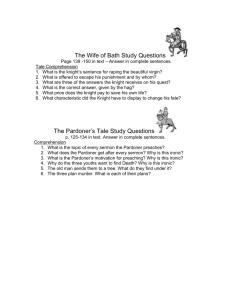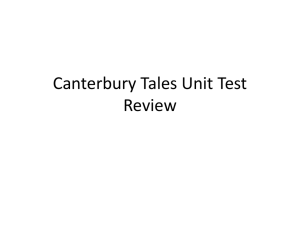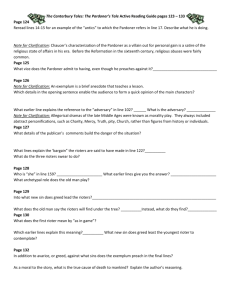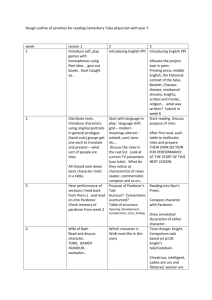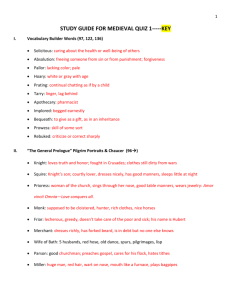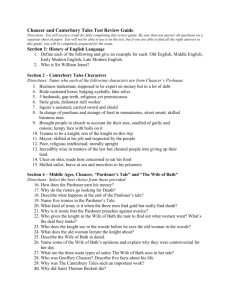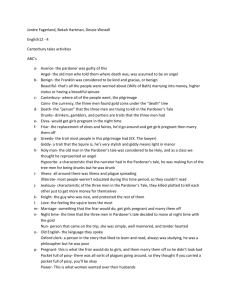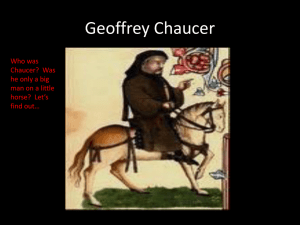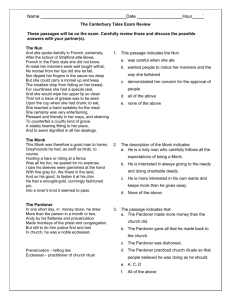The Canterbury Tales
advertisement
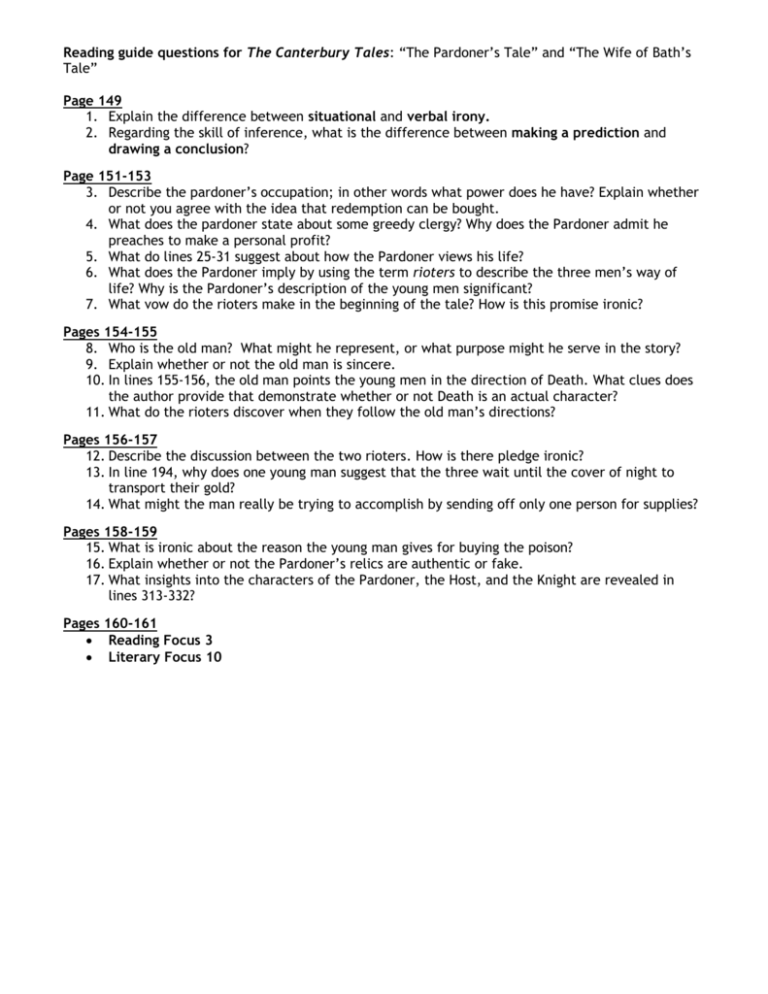
Reading guide questions for The Canterbury Tales: “The Pardoner’s Tale” and “The Wife of Bath’s Tale” Page 149 1. Explain the difference between situational and verbal irony. 2. Regarding the skill of inference, what is the difference between making a prediction and drawing a conclusion? Page 151-153 3. Describe the pardoner’s occupation; in other words what power does he have? Explain whether or not you agree with the idea that redemption can be bought. 4. What does the pardoner state about some greedy clergy? Why does the Pardoner admit he preaches to make a personal profit? 5. What do lines 25-31 suggest about how the Pardoner views his life? 6. What does the Pardoner imply by using the term rioters to describe the three men’s way of life? Why is the Pardoner’s description of the young men significant? 7. What vow do the rioters make in the beginning of the tale? How is this promise ironic? Pages 154-155 8. Who is the old man? What might he represent, or what purpose might he serve in the story? 9. Explain whether or not the old man is sincere. 10. In lines 155-156, the old man points the young men in the direction of Death. What clues does the author provide that demonstrate whether or not Death is an actual character? 11. What do the rioters discover when they follow the old man’s directions? Pages 156-157 12. Describe the discussion between the two rioters. How is there pledge ironic? 13. In line 194, why does one young man suggest that the three wait until the cover of night to transport their gold? 14. What might the man really be trying to accomplish by sending off only one person for supplies? Pages 158-159 15. What is ironic about the reason the young man gives for buying the poison? 16. Explain whether or not the Pardoner’s relics are authentic or fake. 17. What insights into the characters of the Pardoner, the Host, and the Knight are revealed in lines 313-332? Pages 160-161 Reading Focus 3 Literary Focus 10 Reading guide questions for The Canterbury Tales: “The Pardoner’s Tale” and “The Wife of Bath’s Tale” (cont.) Page 161 1. Based on previous notes and the information found in your textbook, define the phrase “interpret characters”. 2. How does the Wife reveal her nature? Pages 162-163 3. What relationships does the Wife explore in her tale? 4. What is the tone of the Wife’s reply to the Pardoner? What does this reveal about her? 5. Why might Chaucer have the Wife of Bath make this disclaimer in line 30? Pages 164-165 6. What is the narrator trying to accomplish in this opening of the tale? 7. Why might the queen choose this question for the knight? 8. Of all the possible answers suggested so far to the knight’s question, which one does the Wife think is the best? Explain your answer. 9. In lines 39-56, describe the Wife’s reaction to the friar’s removal of the fairies. Pages 166-167 10. Explain whether or not you agree with the point the Wife makes about women in lines 115-117. 11. Based on lines 119-126, what does the Wife think about the nature of most women? 12. In lines 119-126, the Wife calls women vicious and indiscreet. Explain how her use of the tale of Midas would illustrate this claim. Pages 168-169 13. What does the digression at the top of page 168 reveal about the Wife’s nature? 14. In lines 181-189, what agreement do the knight and old woman reach? What might be their motivation for this? 15. Lines 33-38 introduced an other-worldy “fairy-tale” setting in the distant past. Re-read lines 16-175. What might the Wife want her listeners to understand about the old crone? 16. Why is it significant that the old woman holds the answer to the knight’s question? 17. The Wife describes the knight’s presentation to the court as “the ringing word of a man’s voice” in lines 211-212. Why is the situation ironic? 18. Explain how does the narrator create suspense in this moment of the story (around line 221) and how this moment represents the Medieval narrative. 19. Based on the knight’s first response in line 234, how might he behave, or what might he do? Pages 170-171 20. In lines 234-248, what detail provides evidence for how the knight feels about marrying the old woman? What can the reader infer about the knight’s character given his reaction to the old woman in lines 274-279? 21. Re-read lines 289-292, paying close attention to the actions the old woman describes. Paraphrase what the old woman says about who is a true gentleman. 22. What is the old woman’s purpose in referring to Dante in lines 301-308? Explain whether or not this an effective means of argument. Pages 172-174 23. According to lines 335-340, what is the source of gentility? 24. What is the old woman’s purpose in mentioning all of these famous figures? 25. Why does the woman differentiate between two types of poverty (worldly and spiritual) in lines 353-367? What is she implying by making this distinction? 26. As the speech progresses, the woman uses logical appeals to persuade the knight her point of view. What logical argument does she use in lines 389-392? How effective is it? 27. What does the knight’s response in lines 406-411 reveal about his character? Page 175 - Literary Focus 7-9
